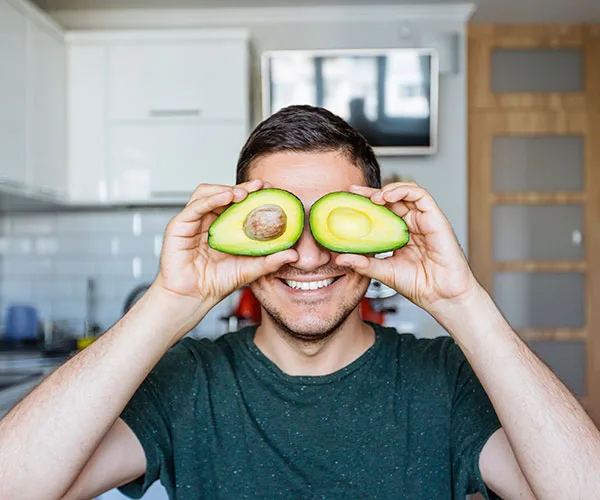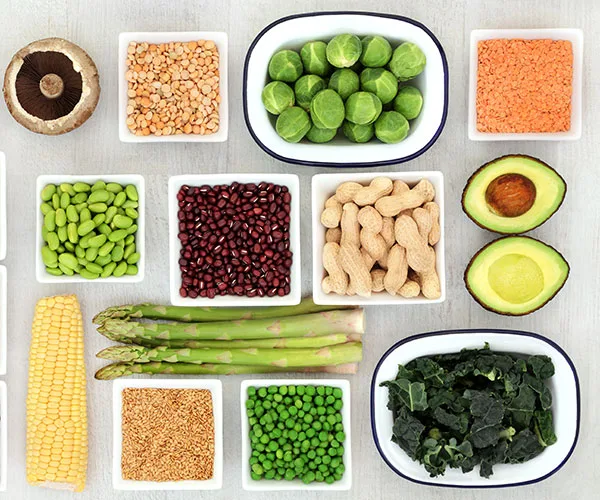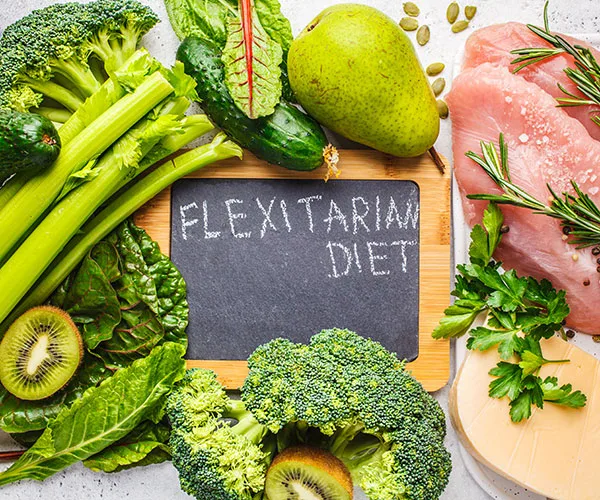There are many reasons why switching to a vegetarian diet is beneficial. It’s good for the planet, your conscience and your health.
But it can be easier said than done. Many meat-eaters want to try plant-based alternatives, but struggle with the new set of rules.
What is a flexitarian?
A flexitarian is a term for someone who follows a vegetarian way of eating 90 per cent of the time, but will indulge in meat dishes 10 per cent of the time.
Often this is when plant-based foods aren’t available or their cravings become too strong. The diet originated when people started to take a more environmental approach to their food choices. When Chris Hemsworth was training for Avengers 3 and 4, he ate a flexitarian diet. We chatted to Chris’ personal trainer, Luke Zocchi, about plant-based diets and training Thor!
If you’re considering a flexitarian diet, here are our top five tips for making the change.

Did you know that vegetarians have a 24 per cent less chance of dying of heart-related diseases?
(Image: Getty Images)Did you know that switching to a more plant-based diet could save up to eight million lives a year by 2050.
It could also lead to healthcare-related savings, and avoid climate change damages by $1.5 trillion.
1. Be kind to yourself
Switching from meat and three veg every night can be daunting.
After all, cooking meat is easy and it’s a great source of protein. It can take some time to learn how to create good vegetarian meals, while making sure your dishes have all the nutrients your body needs.
Unlike vegetarianism or veganism, the flexitarian diet doesn’t expect you to be perfect right away.
Most people who transition from meat-dominant meals try Meat-Free Mondays – one day a week where you eat entirely vegetarian.
When you feel like you’ve built up enough recipes and skills, add another meat-free day. Do this until you’re ready for vegetarian eating to make up 90 per cent of your diet.
Or, if that’s too daunting, make meat the side dish instead of the focus of the meal.
2. Meat-Free Mondays
The great thing about being a flexitarian is you’re able to enjoy the food you love.
While you could save a juicy burger for your cheeky meat meal, we suggest experimenting with meat-free options.
These days, the market is saturated with vegetarian meat products, from beef burger patties to chicken schnitzels. But, sometimes, they can be more expensive than meat. Instead, try a vegie burger patty from an online recipe.
They can be made from inexpensive ingredients like black beans, sweet potato and rice, click here to Women’s Weekly Food for recipe inspiration!

Experiment with products like black beans, sweet potato and rice.
(Image: Getty Images)3. Plant-based protein
Protein is vital for your health, but meat isn’t the only source available. Switch up your meal ideas by adding in other protein sources, such as tofu, tempeh, beans, mushrooms, leafy greens and vegetables.
Try to replace half of your meat protein with another form of plant protein.
For example, if you’re making spaghetti bolognese, do half beef mince and half beans or mushrooms. You’ll be surprised how much it improves the flavour!
You can also add protein powder to smoothies.

There are all sorts of delicious plant-based protein options.
(Image: Getty Images)4. The secret ingredient
Umami is one of the five key taste profiles that your tongue can sense. Umami foods have a full-bodied, savoury flavour.
It’s present in all types of meat, cheese and seafood, along with some plant-based foods such as tomatoes, mushrooms, seaweed, asparagus and potatoes.
Some vegetarians and vegans feel like this flavour profile is missing from their home-cooked meals. However, you can add it by using soy sauce, miso paste, beer or the plant-based foods listed above.

Try making switches and swaps next time you’re eating out.
(Image: Getty Images)5. Switcheroo
If you’ve been a meat-eater your entire life, sometimes you just can’t avoid it. Whether it’s a family dinner or when friends surprise you with a meal at a steak restaurant, you’ve just got to roll with the punches. Even minimising your meat consumption is helping the environment.
Don’t beat yourself up – use these experiences to enable you to make smarter choices next time.
Could you have ordered from the sides menu? Or was there an option that could have been adapted to be vego? It never hurts to ask and most restaurants are accommodating.
Did you know that the Heart Foundation now advises people to limit their consumption of unprocessed beef, lamp, pork and veal to 350 grams a week?
That works out to be about three lean red-meals a week.

Celebrity trainer Luke Zocchi trained Chris Hemsworth for Avengers 3 and 4 where they ate 90 per cent vegan for the two films.
(Image: Instagram @zocobodypro)We chatted to celebrity trainer Luke Zocchi about plant-based diets;
Q. Is it true that men who go vegan will get man boobs?
A. That is a complete lie! I trained Chris Hemsworth for Avengers 3 and 4. We were 90 per cent vegan for both those films and Chris kept on the muscle that he normally would.
Q. If you’re eating a plant-based diet, is there anything you shouldn’t have in excess?
A. Soy sometimes gets a bad rap – the only thing with soy is a lot of it is highly processed. Just like meat, you’ve got to be careful where you get it from. Too much of anything isn’t good. Even if you go vegan, don’t eat just soy the whole time as your main protein source; you can do tempeh or protein shakes. People say it’s hard to get protein by being plant-based, but that’s quite easily fixed by using things like pea protein shakes. If you’re trying to build muscle, do resistance weight training and have a diet to support that. We’ve gotten a bit extreme on our portion sizes of meat. We don’t need to eat that much meat.
Q. Does being vegan give you more energy?
A. To a certain extent. If you do veganism correctly, you’re eating more natural foods that we’re meant to eat. A lot of junk that’s processed isn’t good for you and gives you an energy crash, whereas if you’re eating a good, plant-based diet with nutritious food, you’ll feel better and have more energy.
Q. So you should do your research first?
A. Definitely. I know a lot of people who go vegan and all they eat is Oreos. Everyone’s different – play around with things and see what works.
Q. Finally, what’s it really like working with Chris Hemsworth?
A. He’s such a down-to-earth guy. I can’t fault him – he’s a good person.
Want to train like Chris? Check out Luke’s website here!

